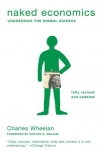Naked Economics Wheelan, Charles (books to read for 13 year olds TXT) 📖

Book online «Naked Economics Wheelan, Charles (books to read for 13 year olds TXT) 📖». Author Wheelan, Charles
But that’s all theory. What do the data show? It turns out that the monkey with a towel can be an investor’s best friend. According to Morningstar, a firm that tracks mutual funds, slightly fewer than half of the U.S. actively managed diversified funds beat the S&P 500 over the past year. A more impressive 66 percent of actively-managed funds beat the S&P 500 over the past five years. But look what happens as the time frame gets longer: Only 45 percent of actively managed funds beat the S&P over a twenty-year stretch, which is the most relevant time frame for people saving for retirement or college. In other words, 55 percent of the mutual funds that claim to have some special stock-picking ability did worse over two decades than a simple index fund, our modern equivalent of a monkey throwing a towel at the stock pages.
If you had invested $10,000 in the average actively managed equity fund in 1973, when Malkiel’s heretical book A Random Walk Down Wall Street first came out, it would be worth $355,091 today (many editions later). If you had invested the same amount of money in an S&P 500 index fund, it would now be worth $364,066.
Data notwithstanding, the efficient markets theory is obviously not the most popular idea on Wall Street. There is an old joke about two economists walking down the street. One of them sees a $100 bill lying in the street and points it out to his friend. “Is that a $100 bill lying in the gutter?” he asks.
“No,” his friend replies. “If it were a $100 bill, someone would have picked it up already.”
So they walk on by.
Neither the housing market nor the stock market has behaved lately in ways consistent with such a sensible and orderly view of human behavior. Some of the brightest minds in finance have been chipping away at the efficient markets theory. Behavioral economists have documented the ways in which individuals make flawed decisions: We are prone to herd-like behavior, we have too much confidence in our own abilities, we place too much weight on past trends when predicting the future, and so on. Given that a market is just a collection of individuals’ decisions, it stands to reason that if individuals get things wrong in systematic ways (like overreacting to good and bad news), then markets can get things wrong, too (like bubbles and busts).
There is even a new field, neuroeconomics, that combines economics, cognitive neuroscience, and psychology to explore the role that biology plays in our decision making. One of the most bizarre and intriguing findings is that people with brain damage may be particularly good investors. Why? Because damage to certain parts of the brain can impair the emotional responses that cause the rest of us to do foolish things. A team of researchers from Carnegie Mellon, Stanford, and the University of Iowa conducted an experiment that compared the investment decisions made by fifteen patients with damage to the areas of the brain that control emotions (but with intact logic and cognitive functions) to the investment decisions made by a control group. The brain-damaged investors finished the game with 13 percent more money than the control group, largely, the authors believe, because they do not experience fear and anxiety. The impaired investors took more risks when there were high potential payoffs and got less emotional when they made losses.7
This book is not prescribing brain injury as an investment strategy. However, behavioral economists do believe that by anticipating the flawed decisions that regular investors are likely to make, we can beat the market (or at least avoid being ravaged by it). Yale economist Robert Shiller first challenged the theory of efficient markets in the early 1980s. He became much more famous for his book Irrational Exuberance, which argued in 2000 that the stock market was overvalued. He was right. Five years later he argued that there was a bubble in the housing market. He was right again.
If irrational investors are leaving $100 bills strewn about, shouldn’t we be able to pick them up somehow? Yes, argues Richard Thaler, a University of Chicago economist (and the guy who took away the bowl of cashews from his guests back in Chapter 1). Thaler has even been willing to put his money where his theory is. He and some collaborators created a mutual fund that would take advantage of our human imperfections: the behavioral growth fund. I will even admit that after I interviewed Mr. Thaler for Chicago public radio, I decided to toss aside my strong belief in efficient markets and invest a small sum in his fund. How has it done? Very well. The behavioral growth fund has produced an average return of 4.5 percent a year since its inception, compared to an average annual return of 2.3 percent for the S&P 500.
The efficient markets theory isn’t going anywhere soon. In fact, it’s still a crucial concept for any investor to understand, for two reasons. First, markets may do irrational things, but that doesn’t make it easy to make money off those crazy movements, at least not for long. As investors take advantage of a market anomaly, say by buying up stocks that have been irrationally underpriced,





Comments (0)